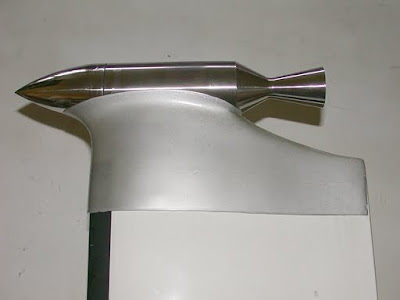Soon Fighter Planes are going to loose their tail

McDonnell Douglas and the National Aeronautics and Space Administration (NASA) have developed a tailless research aircraft that could dramatically change the design of future stealthy fighters. Named the X-36, the vehicle has no vertical or horizontal tails and uses new split ailerons to provide yaw (left and right) and pitch (up and down) directional control. This innovative design promises to reduce weight, drag and radar signature and increase range, maneuverability and survivability of future fighter aircraft. The 28-percent scale prototype was designed, developed and produced in just 28 months for only $17 million. The X-36 began a six-month flight test program in the summer of 1996.
McDonnell Douglas and the National Aeronautics and Space Administration (NASA) embarked on a joint project in 1994 to develop a prototype fighter aircraft designed for stealth and agility. The result -- after only 28 months -- was a subscale tailless aircraft called the X-36. The 28 percent scale, remotely piloted X-36 has no vertical or horizontal tails, yet it is expected to be more maneuverable and agile than today's fighters. In addition, the tailless design reduces the weight, drag and radar cross section typically associated with traditional fighter aircraft.
In a series of flight tests, the low-cost X-36 research vehicle demonstrated the feasibility of using new flight control technologies in place of vertical and horizontal tails to improve the maneuverability and survivability of future fighter aircraft. During flight, the X-36 used new split ailerons and a thrust-vectoring nozzle for directional control. The Ailerons not only split to provide yaw (right-left) control, but also raise and lower asymmetrically to provide roll control. The X-36 vehicle also incorporated an advanced, single-channel digital fly-by-wire control system developed with commercially available components.
Fully fueled, the X-36 prototype weighed 1,300 pounds. It is 19 feet long and measures 11 feet at its widest point. It is 3 feet high and is powered by a Williams Research F112 engine that provides about 700 pounds of thrust. Using a video camera in the nose of the vehicle, a pilot controls the flight of the X-36 from a virtual cockpit -- complete with head-up display (HUD) -- in a ground-based station. This pilot-in-the-loop approach eliminates the need for expensive and complex autonomous flight control systems.
McDonnell Douglas has been working under contract to NASA Ames Research Center, Moffett Field, Calif., since 1989 to develop the technical breakthroughs required to achieve tailless agile flight. Based on the positive results of extensive wind tunnel tests, McDonnell Douglas in 1993 proposed building a subscale tailless research aircraft. In 1994 McDonnell Douglas and NASA began joint funding of the development of this aircraft, now designated the X-36. Under the roughly 50/50 cost-share arrangement, NASA Ames is responsible for continued development of the critical technologies, and McDonnell Douglas for fabricating the aircraft.

McDonnell Douglas built the X-36 with a combination of advanced, lowcost design and manufacturing techniques pioneered by the company's Phantom Works research-and-development operation.
Among these techniques are:
- advanced software development tools for rapid avionics prototyping;
- low-cost tooling molds;
- composite skins cured at low termperatures without the use of autoclaves, and;
- high speed machining of unitized assemblies.
Two identical subscale research vehicles were produced by the team for use in the flight test program. Including design and production of the two aircraft and flight testing, the total cost of the X-36 program was only $17 million. A total of 25 flights, conducted by McDonnell Douglas, took place during a six-month flight test program designed to prove the aircraft's superior agility. Initial tests focused on the low-speed, high angle-of-attack performance of the X-36.













































